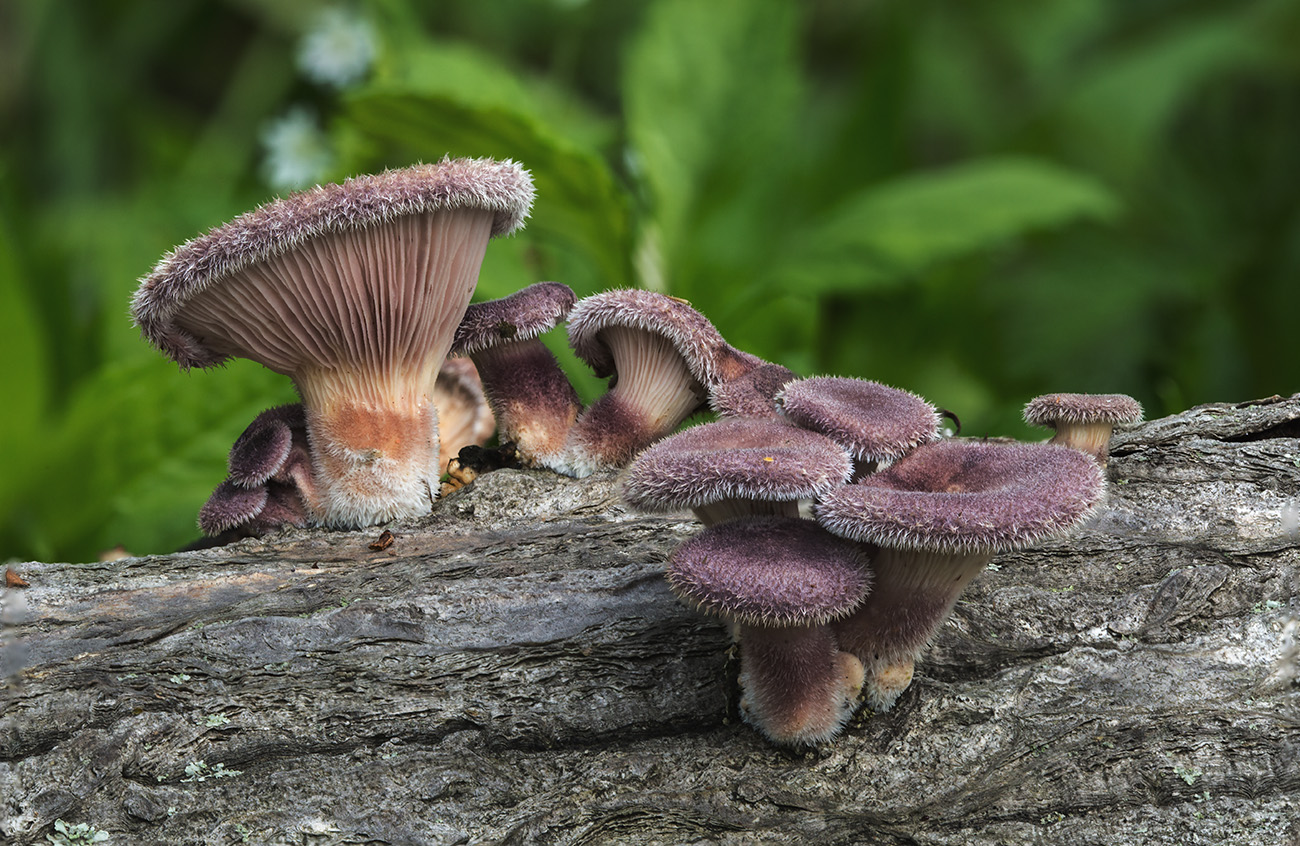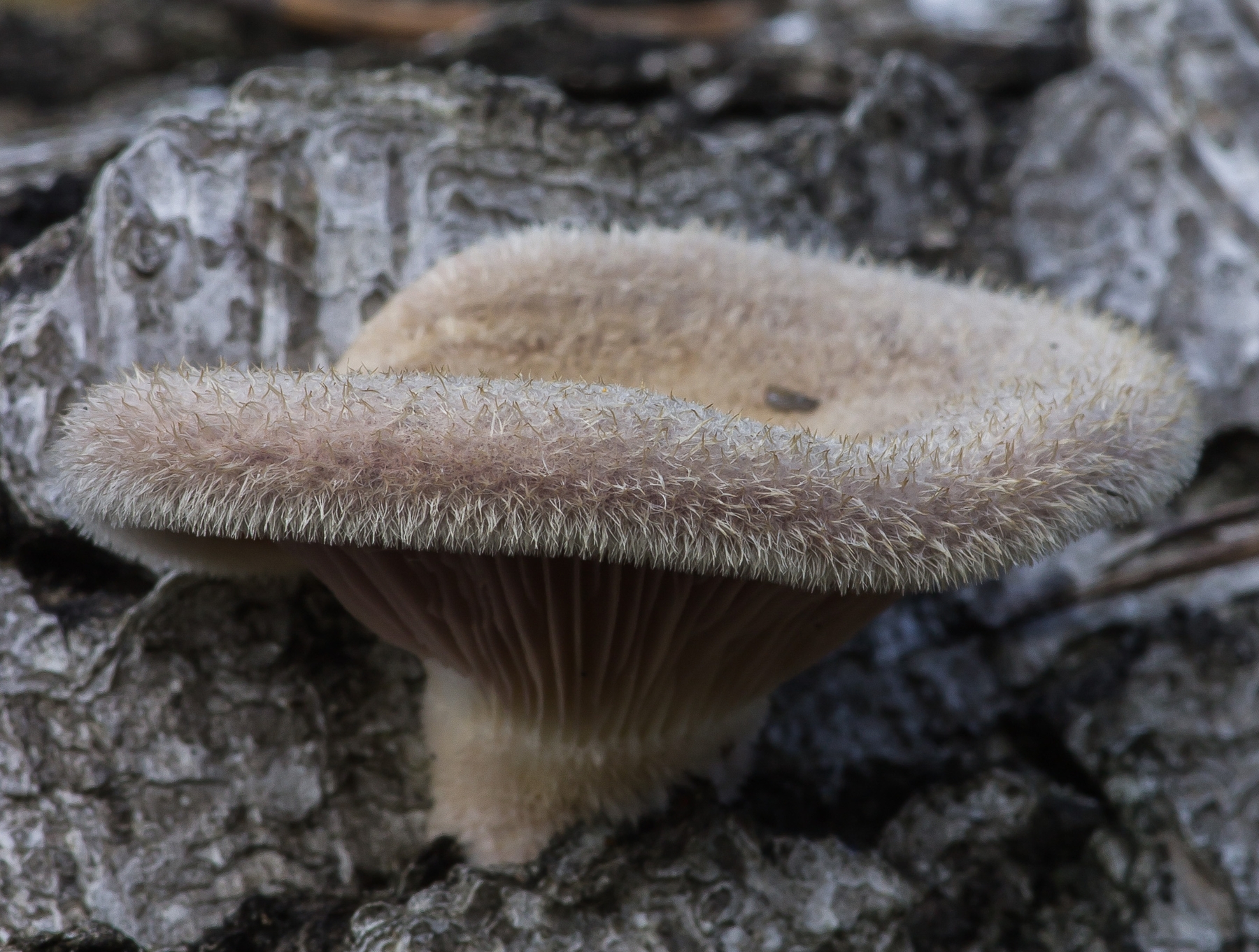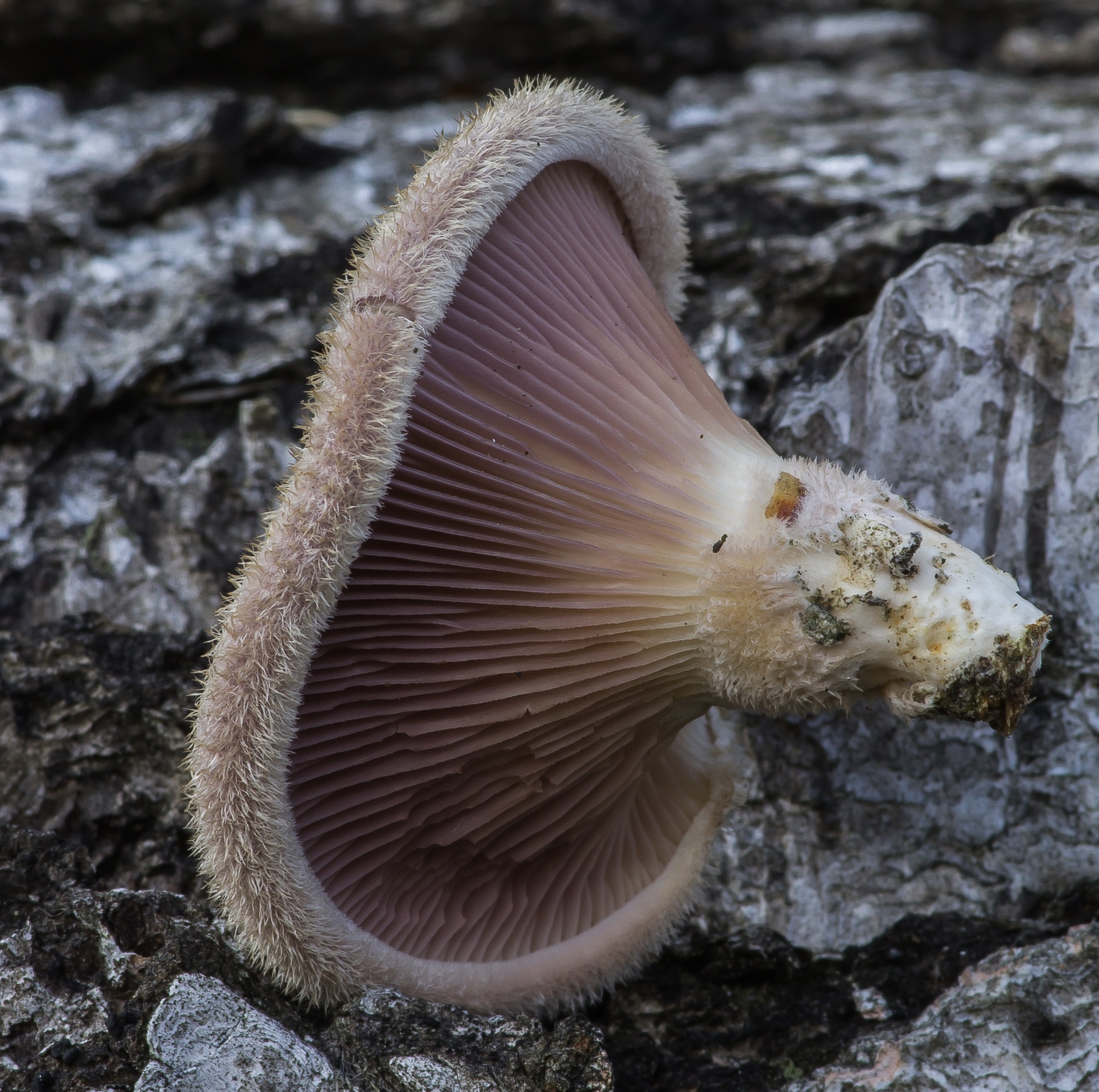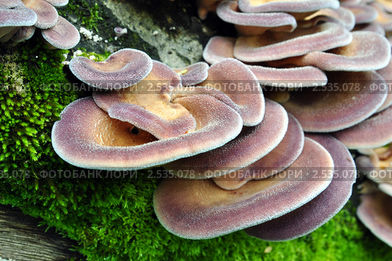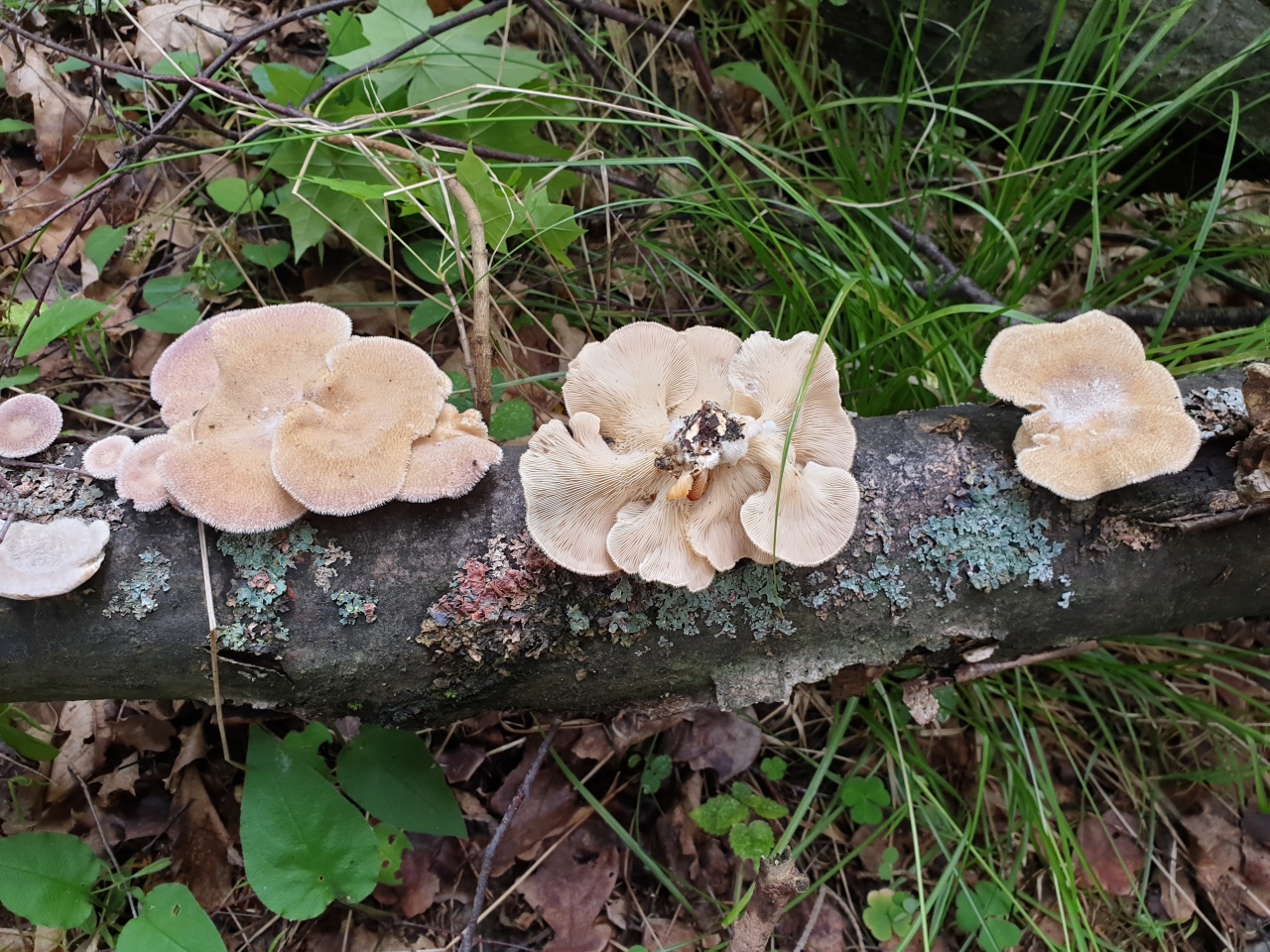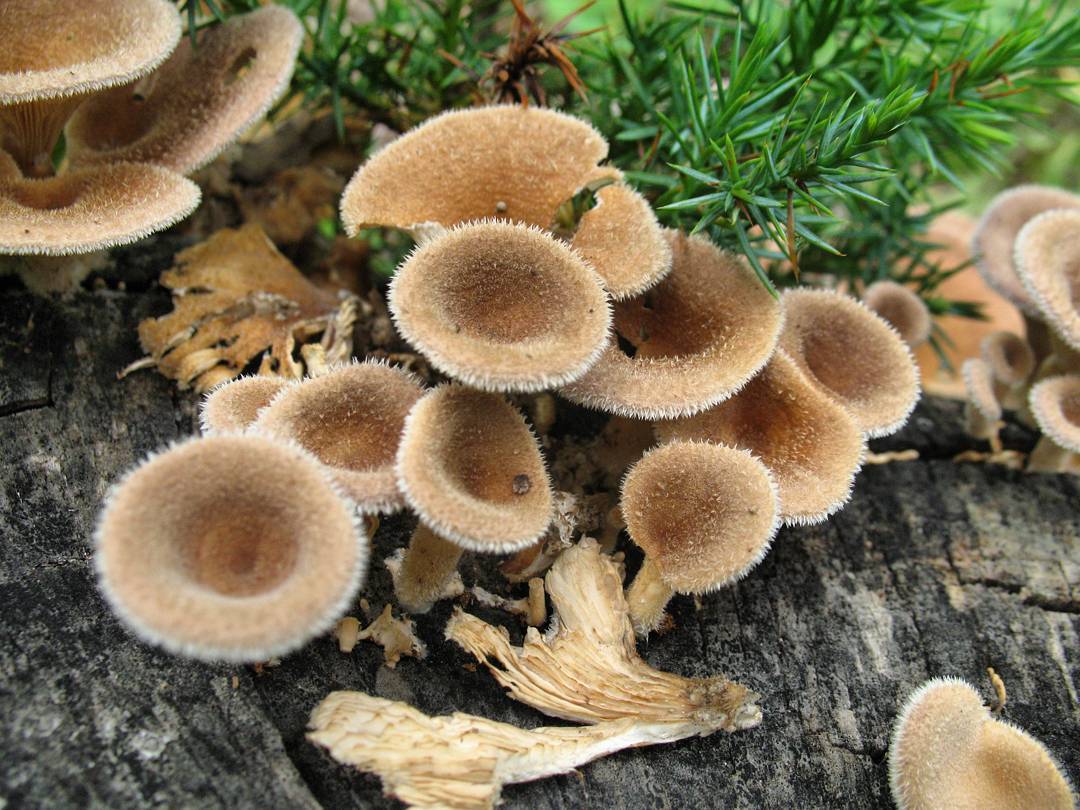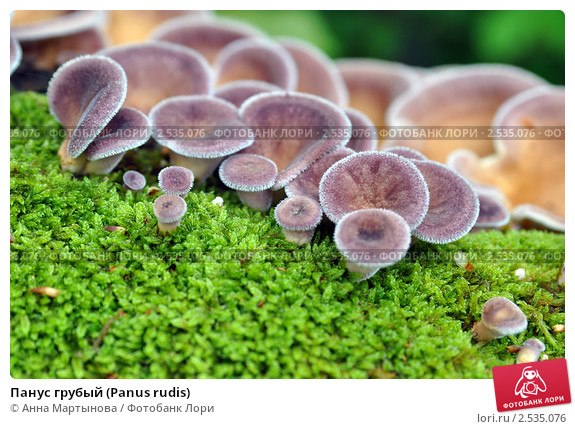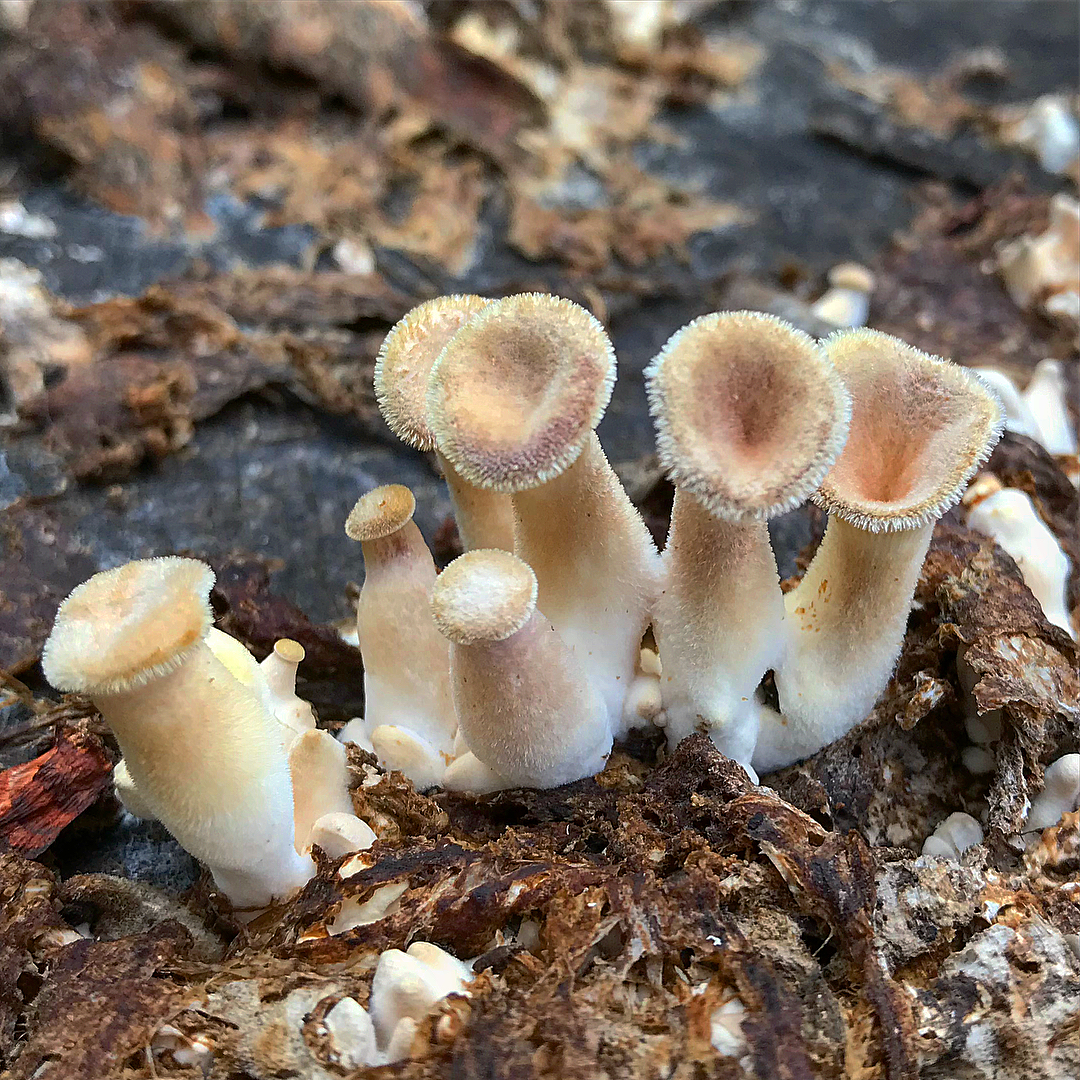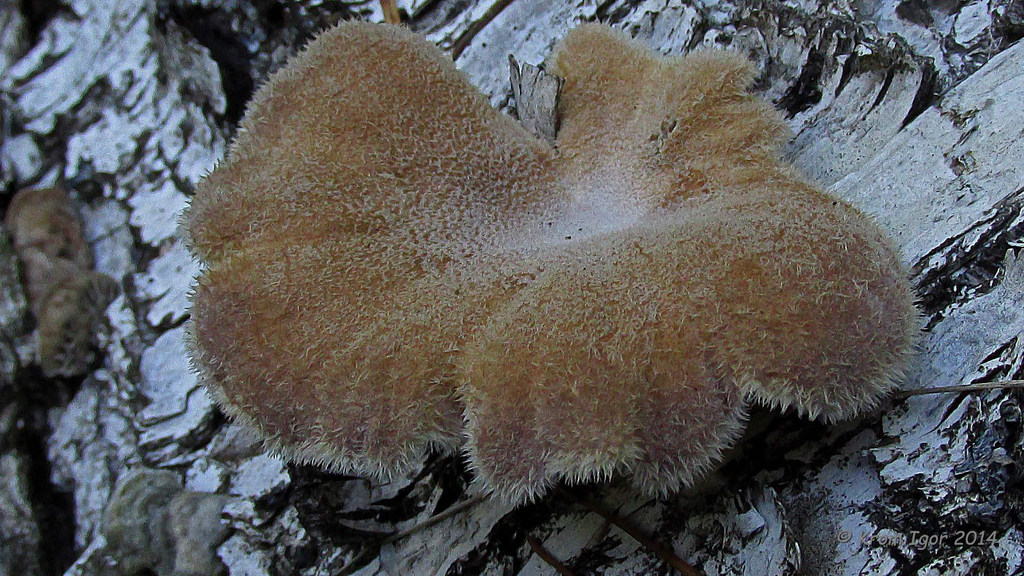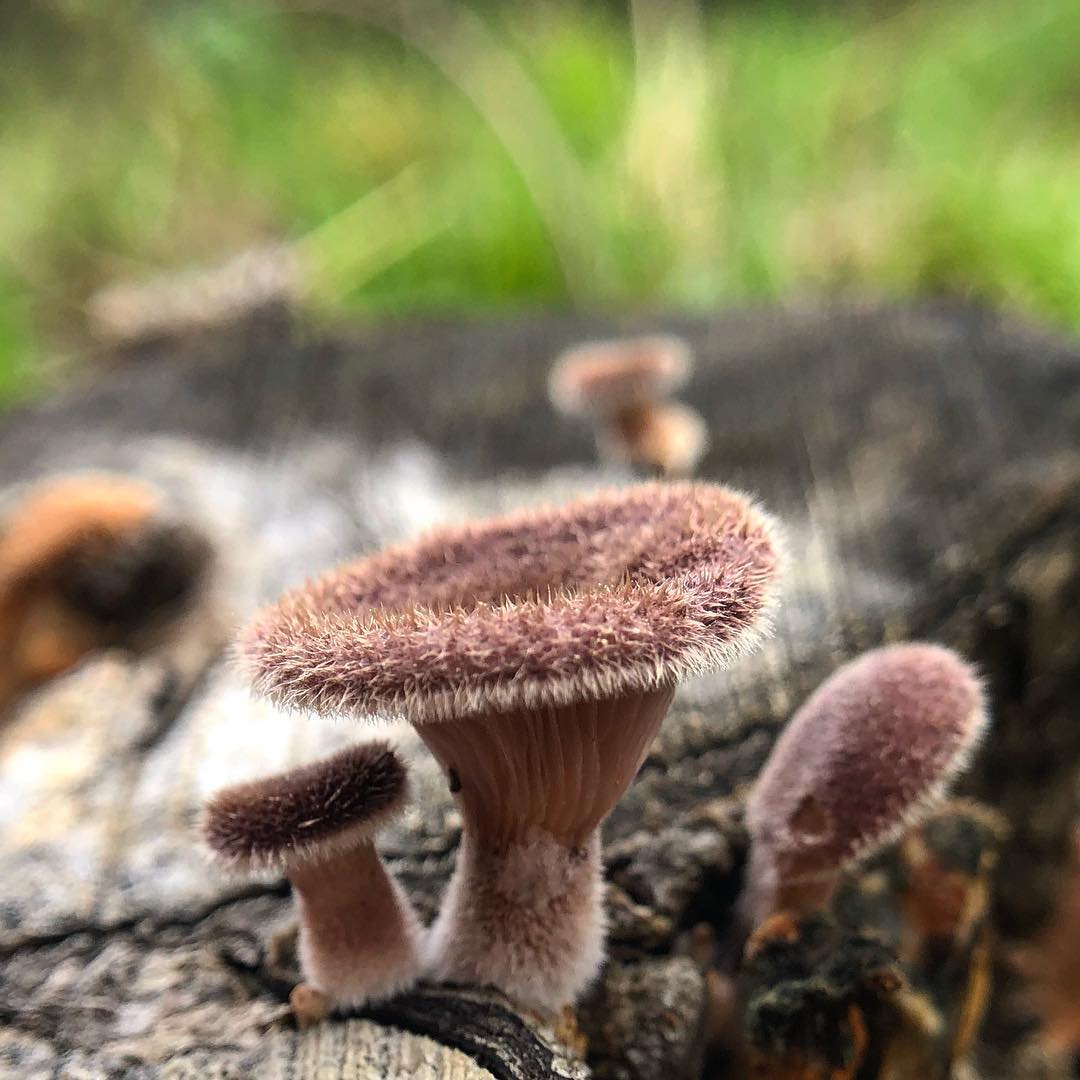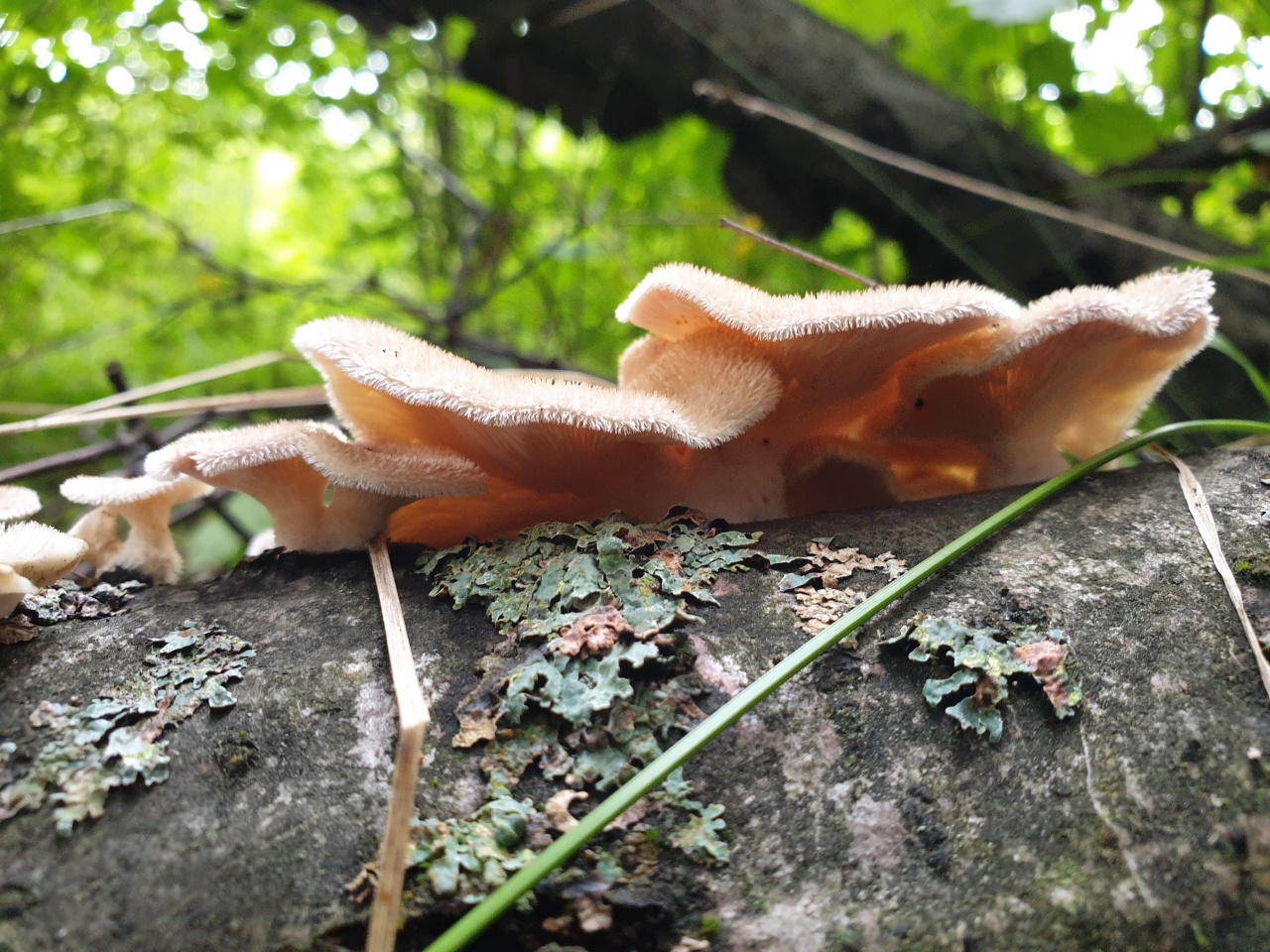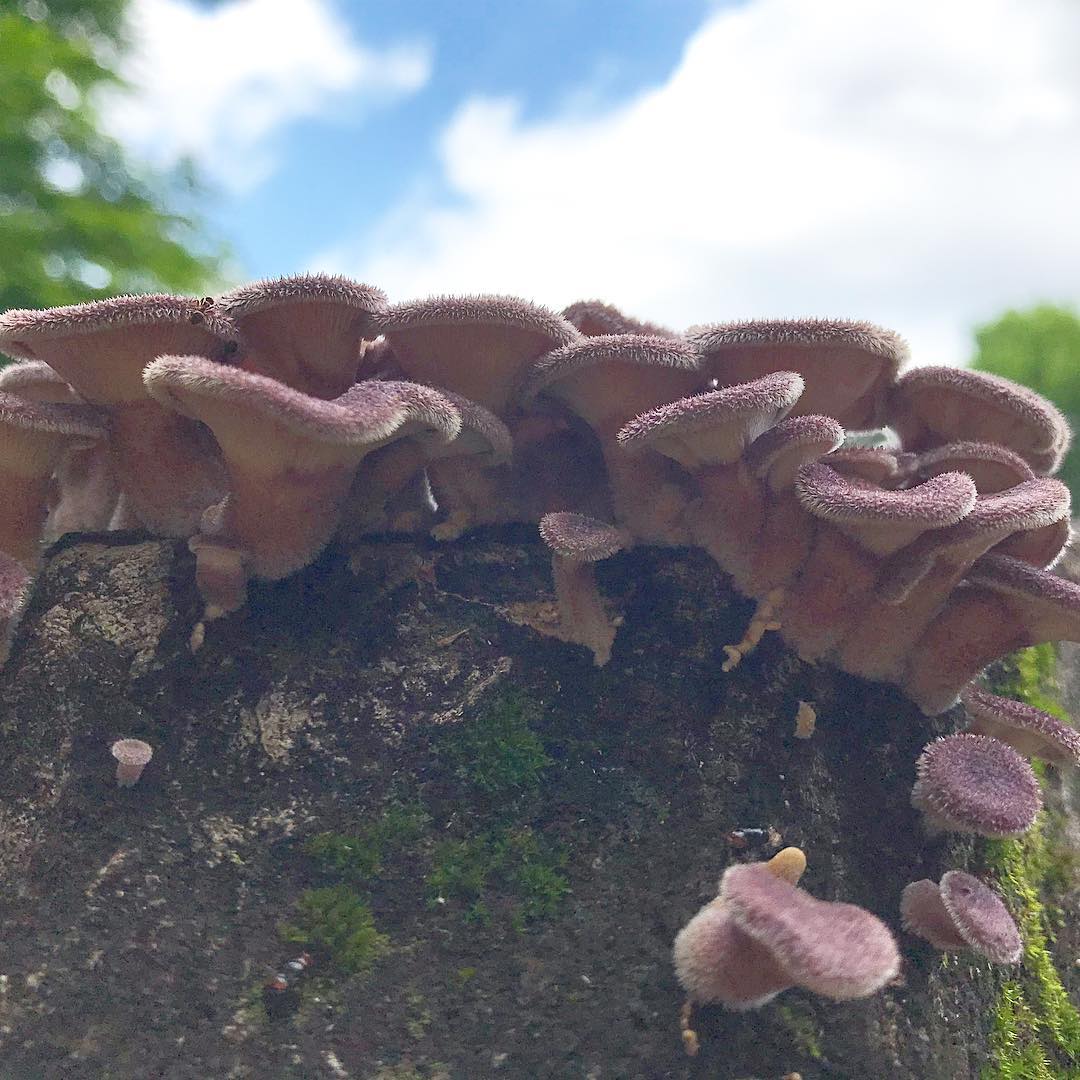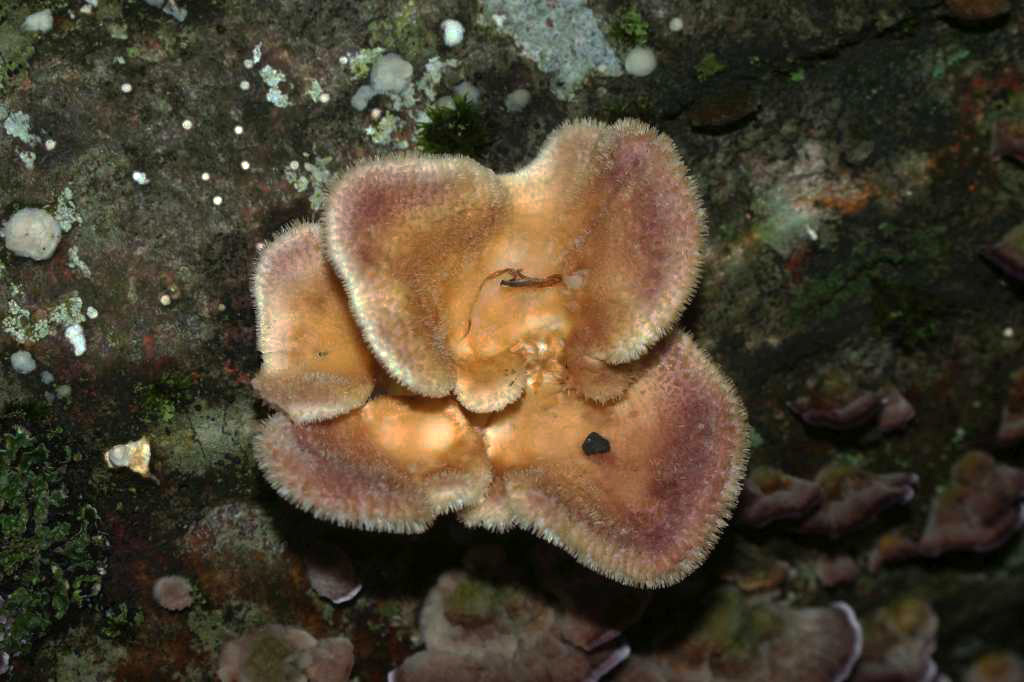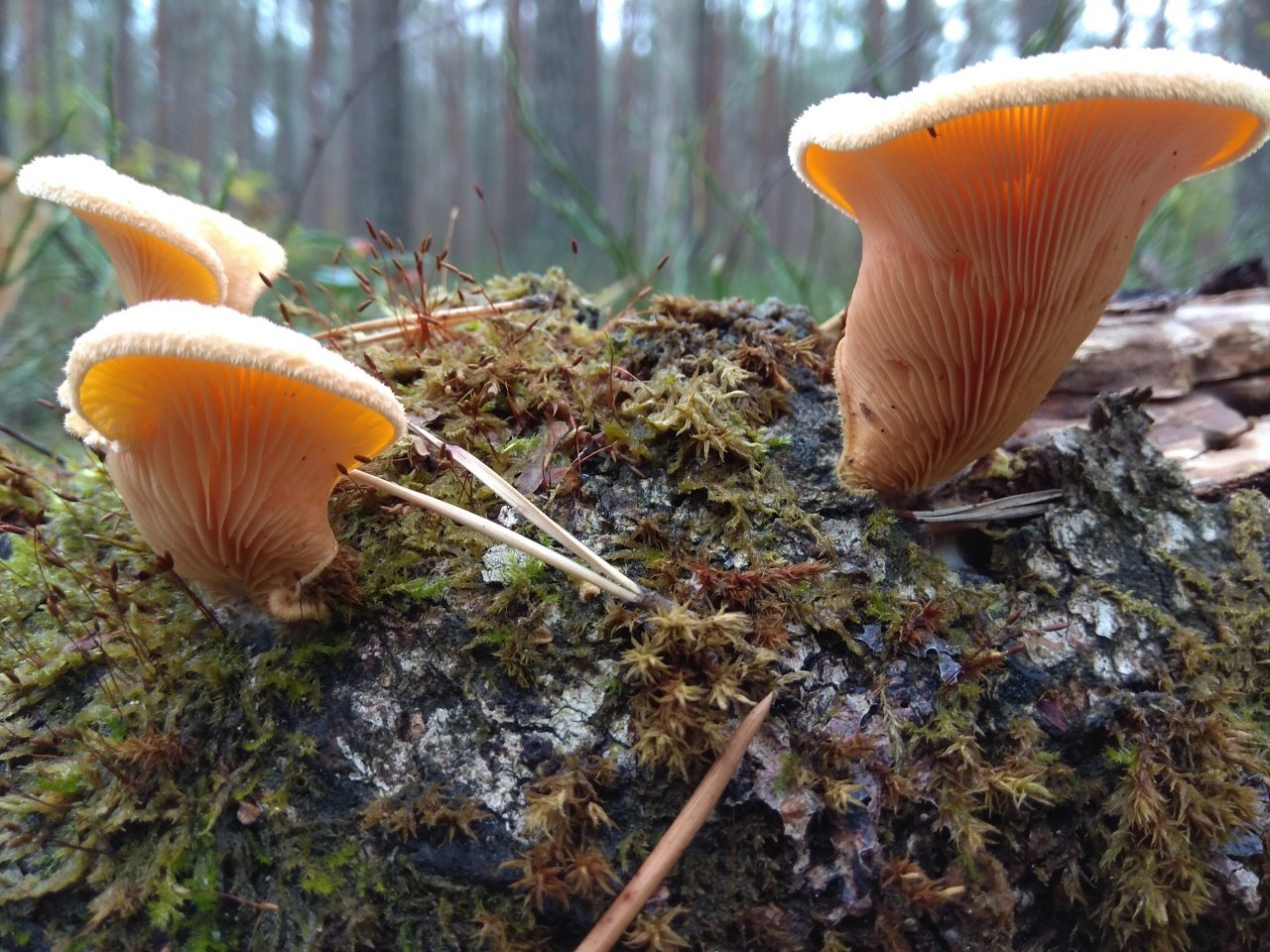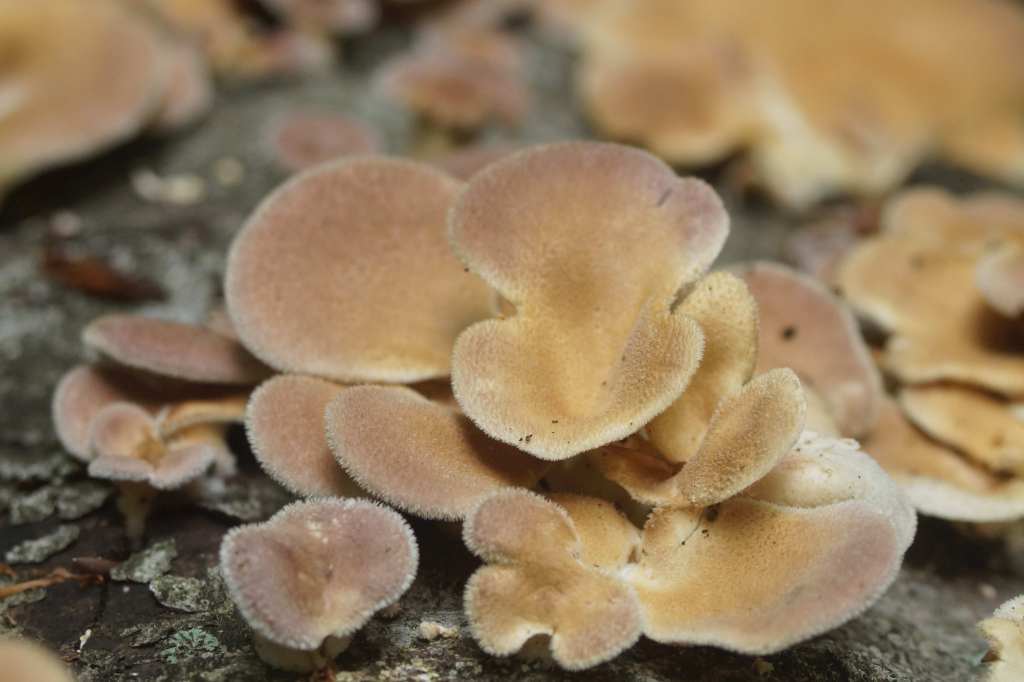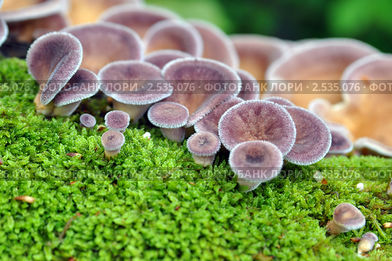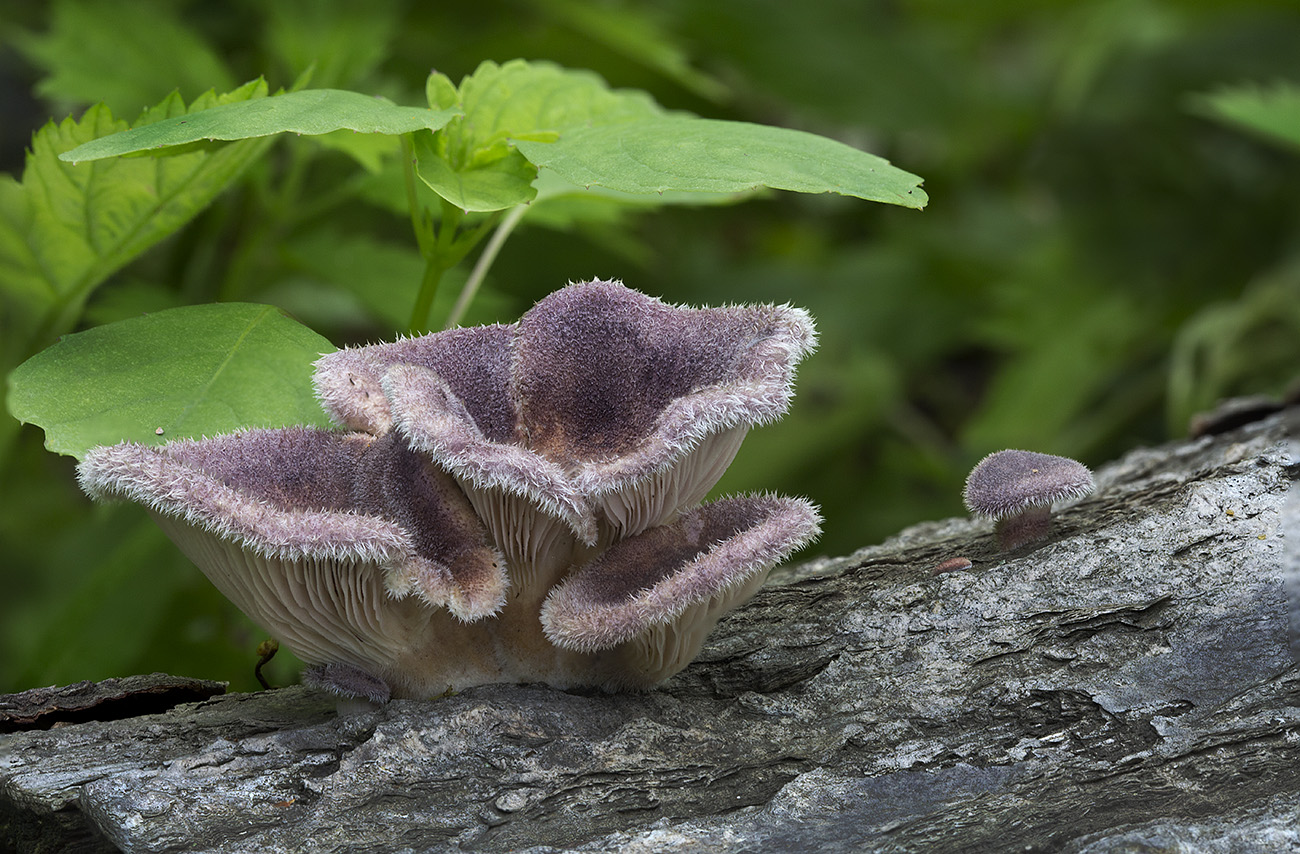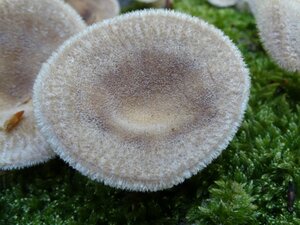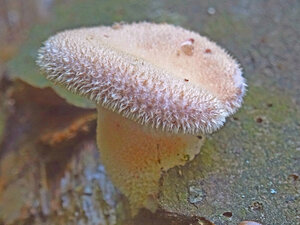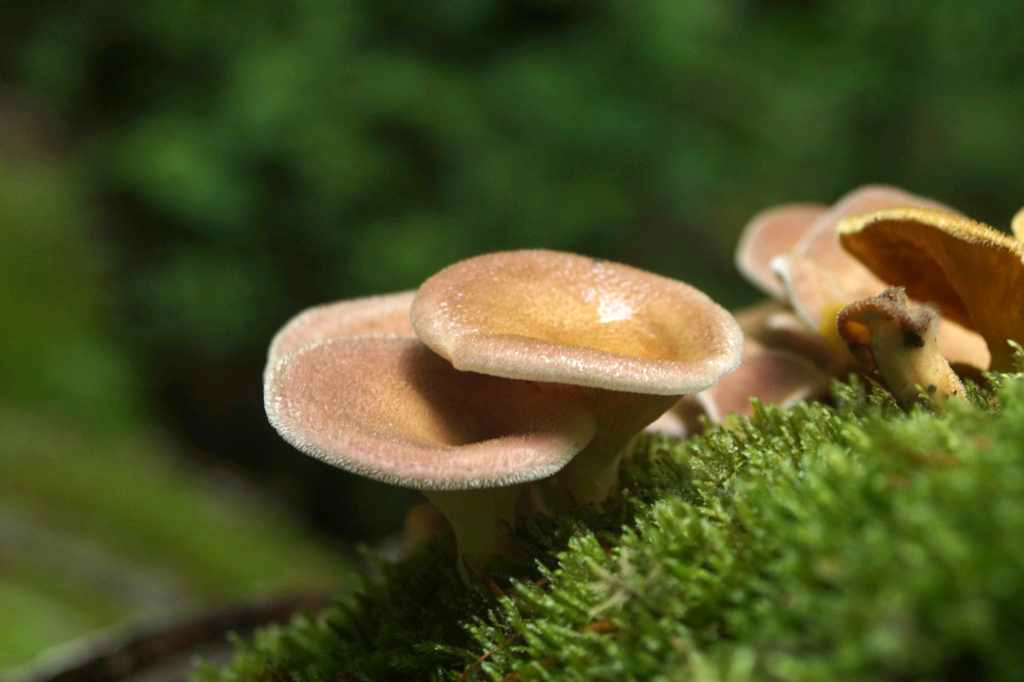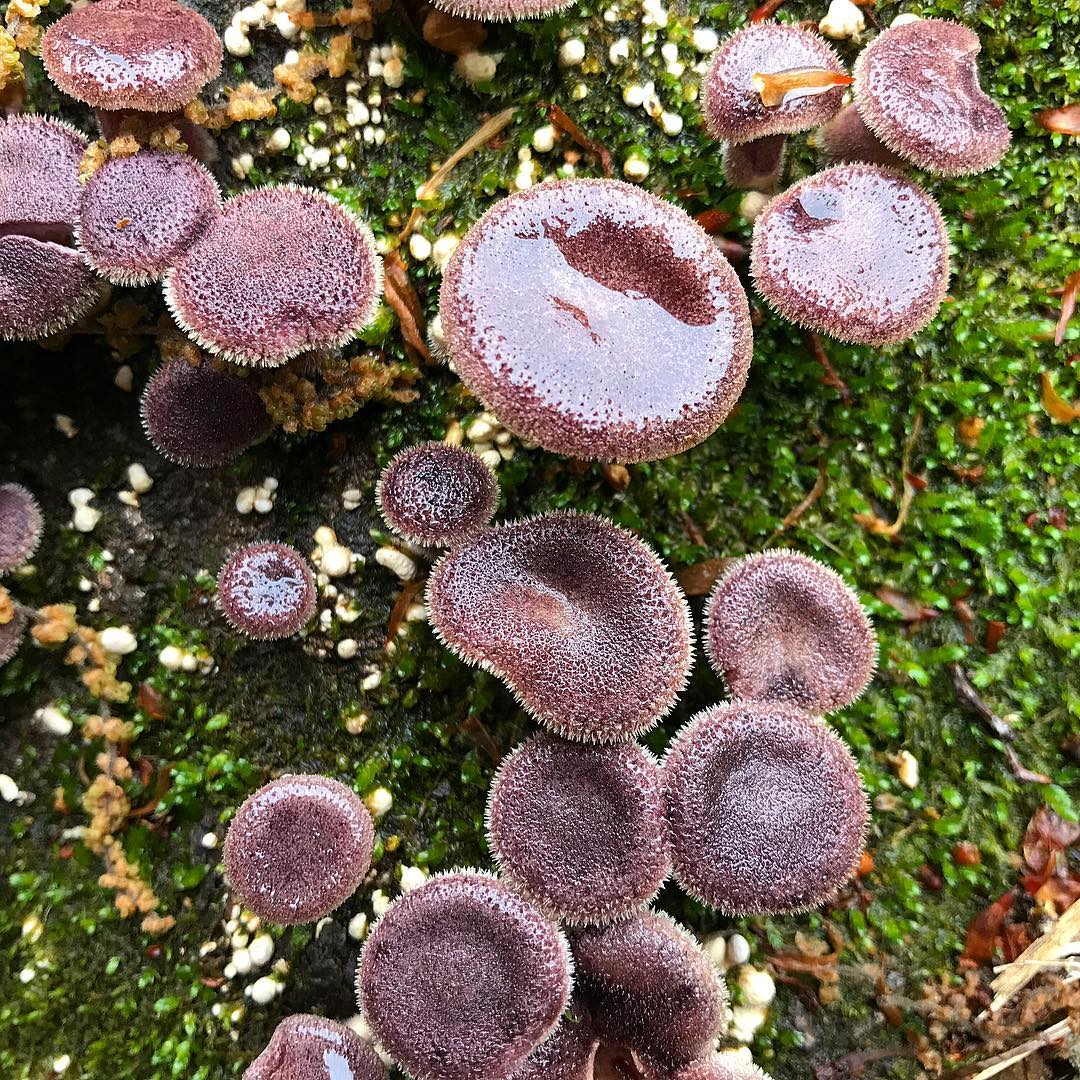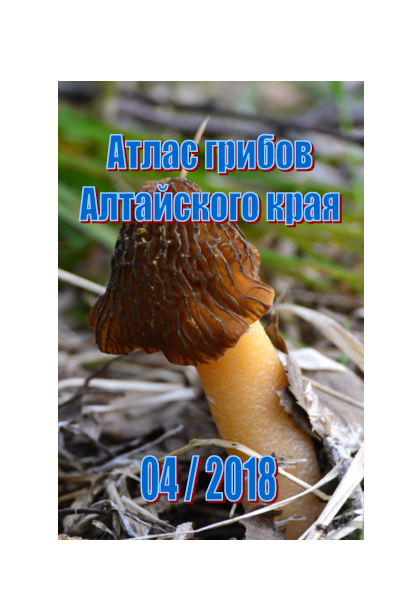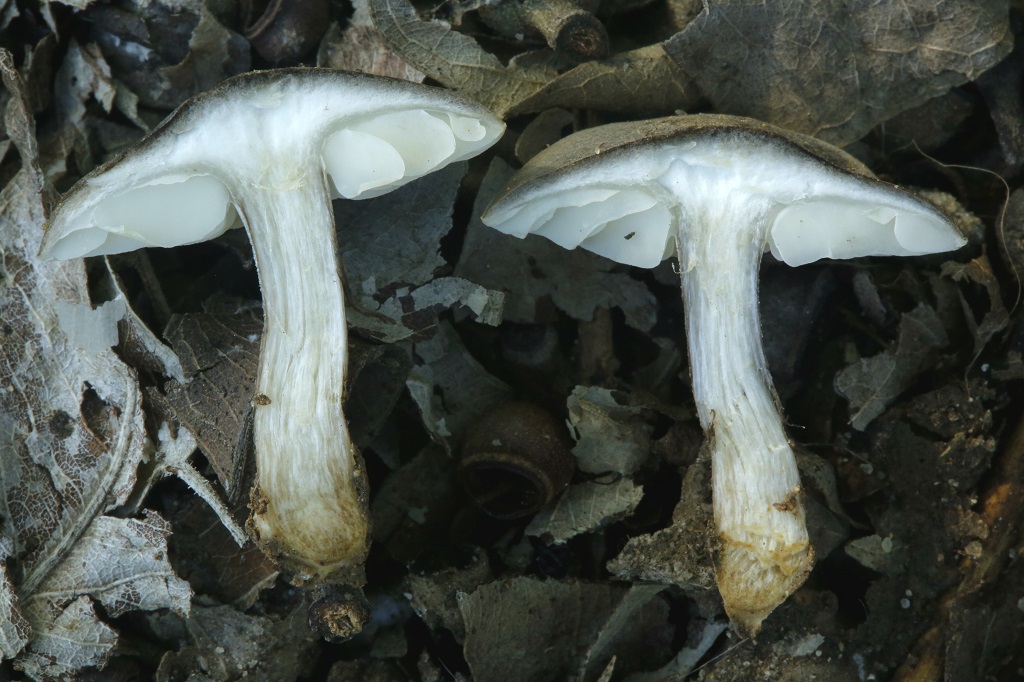Tiger saw-leaf (Lentinus tigrinus)
Current title
| Index Fungorum | Lentinus tigrinus (Bull.) Fr. | |
| MycoBank | Lentinus tigrinus (Bulliard) Fries |
Systematic position
Etymology of the species epithet
Tigrinus, a, um, brindle (i.e. striped). From tigris, is m, f, tiger or tigress + -inus, quality.
Synonyms
Habit
Fruit body: Cap and stem (agaricoid)
Hymenophore: Lamellar (including folded or with rudimentary plates)
Hat
The cap is 1 - 10 cm in diameter, first convex with a depression in the center, then funnel-shaped, with the edge turned down, dry, fleshy-leathery, white, creamy or yellowish. Covered with large and small, usually adjacent, radially diverging scales.
The plates are descending, narrow, whitish-cream, with an uneven serrated-serrated, sometimes split edge.
Leg
The stem is thin, about 0.5 cm in diameter and 3 - 5 cm long, narrowed, central or eccentric, brownish, with small black-brown scales, darker towards the base.
Pulp
The pulp is white, dense, reddening at the break.
Microscopy
The hyphae system is dimitic. Generative hyphae 2.5 - 8 μm in diameter, with buckles, moderately branching in the pedicle and pulp of the cap, densely located in the mediostratus of the plates with the formation of an irregular or subdivergent tram, in the cuticle (epicutis) radially located hyaline or with thickened brownish walls, strongly swollen (up to 8 μm in diameter).
Skeletal hyphae 2 - 5 µm in diameter, hyaline, predominate in the pedicle.
Cheilocystids 30 - 50 × 3 - 7.5 µm, cylindrical to almost clavate, thick-walled, hyaline, in pegs.
Pleurocystids are absent; in hymenia, hyphae pegs are common (hyphae 2 - 5 µm wide).
Basidia 25 - 35 × 4 - 7.5 µm, elongate-clavate, 4-spore, with a well-defined central constriction and a buckle at the base.
Spores 6 - 10 × 2.5 - 3.5 µm, cylindrical to almond-shaped, slightly unequal, hyaline, smooth, thin-walled, not amyloid; white in bulk.
Ecology and distribution
Substance: Woody plants (living trees, bark and dead wood)
It grows in groups on stumps and valez of deciduous species.
There is no information about the location in the Novosibirsk region.
Fruiting
June - September.
The divisions correspond to the decades of the month.
Nutritional properties
Only young fruiting bodies can be consumed. With age, it becomes tough, "rubbery".
Similar species
Small-scaled neolentinus (Neolentinus lepideus) - grows on stumps and valezh of conifers.
Related materials
- Zmitrovich I.V., Malysheva V.F., Malysheva E.F., Spirin V.A.Pleurotoid fungi of the Leningrad region. - SPb .: "VIZR", 2004. - 124 p. - S. 81.
- Gorlenko M.V., Bondartseva M.A., Garibova L.V., Sidorova I.I., Sizova T.P. Mushrooms of the USSR. - M .: "Mysl", 1980. - 303 p. - P. 186.
Link to this page for prints
Ageev D.V., Bulonkova T.M.
Share link
Discussions
2 comments on "" Tiger saw-leaf (Lentinus tigrinus) ""
Specialists say that ours is L. lepideus, not tigrinus. It grows on deciduous wood, and ours is purely coniferous. Fig knows, they look alike ...
Yes. Thanks. A new card Lentinus lepideus has been created. Lentinus tigrinus now requires photographs.
| Identifier: | 847 |
| Responsible: | Dmitry Ageev |
| Date of creation: | 2012-08-13T04: 33: 37 |
| Last modified date: | 2017-05-11T11: 19: 13 (Dmitry Ageev) |
OOO OOO OOO OOO OOO OOO OOO OOO OOO OOO OOO OOO OOO OOO OOO OOO OOO OOO OOO OOO OOO OOO OOO OOO OOO OOO OOO OOO OOO OOO OOO OOO OOO OOO OOO OOO OOO OOO OOO OOO OOO OOO OOO OOO OOO OOO OOO OOO OOO OOO OOO OOO OOO OOO OOO OOO OOO OOO OOO OOO OOO OOO OOO OOO OOO OOO OOO OOO OOO OOO OOO OOO OOO OOO OOO OOO OOO OOO OOO OOO OOO OOO OOO OOO OOO OOO OOO OOO OOO OOO OOO OOO OOO OOO OOO OOO OOO OOO OOO OOO OOO OOO OOO OOO OOO OOO OOO OOO OOO OOOì
Age restrictions
Federal Law of the Russian Federation of December 29, 2010 No. 436-FZ "On the Protection of Children from Information Harmful to Their Health and Development."
basic information
ID
425760420
You can edit:
No
Can be hidden by settings privacy:
No
Unique identifier for the user.
Domain
You can edit:
Yes
Required to fill:
No
Can be hidden by privacy settings:
No
The domain is used to set a beautiful, memorable link to the user's VKontakte page.
Name
Andriyan
You can edit:
Yes
Required to fill:
Yes
Can be hidden by privacy settings:
No
Surname
Panus
You can edit:
Yes
Required to fill:
Yes
Can be hidden by privacy settings:
No
middle name
not indicated
You can edit:
No
Required to fill:
No
Can be hidden by privacy settings:
No
VKontakte can no longer edit the middle name for users for whom it was not specified earlier.
Floor
female
You can edit:
Yes
Required to fill:
Yes
Can be hidden by privacy settings:
No
Date of Birth
hidden or not listed
You can edit:
Yes
Required to fill:
Yes
Can be hidden by privacy settings:
Yes
VKontakte has the ability to hide the date of birth in whole or in part (in this case, only the day and month of birth will be displayed).
False doubles
Due to the fact that the mushroom grows in strictly defined places, it is rather difficult to confuse it with others. At the same time, there are still varieties that look similar to him. You can see them better in the photo.
| Name | Colour | Cutting location | Growing area | Danger |
| Sleeper mushroom | Light, whitish or yellowish with brown scales | Slightly turns yellow, turns red | On rotting pines, sleepers and poles | Edible |
| Goblet sawfoot | Red & white | Color does not change | Southern areas, decaying deciduous trees | Inedible |
| Tiger saw-leaf | White with brown scales | Blushes | Coniferous forests, dead wood | Conditionally edible |
Basically, connoisseurs are engaged in the collection of saw-leaves, many indicate the excellent taste of the mushroom. It is worth noting that the well-known Shiitake also belongs to this genus.
Rough panus (bristly saw-leaf): photo and description
| Name: | Panus rough |
| Latin name: | Panus rudis |
| Type of: | Conditionally edible |
| Synonyms: | Bristly sawfoot, Bristly Lentinus, Agaricus strigosus, Lentinus strigosus, Panus fragilis, Lentinus lecomtei |
| Specifications: |
|
| Systematics: |
|
Rough Panus is a representative of a large group of the Panus clan. These mushrooms are also called saw-leaves. The Latin name for the bristly saw-leaf is Panus rudis. The genus is distinguished by a high concentration of protein. Mature specimens are much tougher than young ones, which is the reason for the name of the species. At the same time, the latter are well absorbed, do not create problems for the work of the digestive tract. Another feature that gave the mushroom its name is the ability to destroy wood on trees and stumps. Even artificial structures on which panus grow do not remain unharmed.
Definitioner
Lat. Basidia. A specialized structure of sexual reproduction in fungi, inherent only in Basidiomycetes. Basidia are terminal (end) elements of hyphae of various shapes and sizes, on which spores develop exogenously (outside).
Basidia are diverse in structure and method of attachment to hyphae.
According to the position relative to the axis of the hypha, to which they are attached, three types of basidia are distinguished:
Apical basidia are formed from the terminal cell of the hypha and are located parallel to its axis.
Pleurobasidia are formed from lateral processes and are located perpendicular to the axis of the hypha, which continues to grow and can form new processes with basidia.
Subasidia are formed from a lateral process, turned perpendicular to the axis of the hypha, which, after the formation of one basidium, stops its growth.
Based on morphology:
Holobasidia - unicellular basidia, not divided by septa (see Fig. A, D.).
Phragmobasidia are divided by transverse or vertical septa, usually into four cells (see Fig. B, C).
By type of development:
Heterobasidia consists of two parts - hypobasidia and epibasidia developing from it, with or without partitions (see Fig. C, B) (see Fig. D).
Homobasidia is not divided into hypo- and epibasidia and in all cases is considered holobasidia (Fig. A).
Basidia is the place of karyogamy, meiosis and the formation of basidiospores. Homobasidia, as a rule, is not functionally divided, and meiosis follows karyogamy in it. However, basidia can be divided into probasidia - the site of karyogamy and metabasidia - the site of meiosis. Probasidium is often a dormant spore, for example in rust fungi. In such cases, probazidia grows with metabasidia, in which meiosis occurs and on which basidiospores are formed (see Fig. E).
See Karyogamy, Meiosis, Gifa.
Amyloid (Amyloid structure)
The structure is called amyloid if from Melzer's reagent (solution of 0.5 g of crystalline iodine + 1.5 g of potassium iodide + 20 ml of chloral hydrate + 20 ml of distilled water) turns blue, violet, sometimes almost black.
How rheumatoid pannus is formed
Rheumatoid arthritis causes the immune system to attack the thin synovium or synovium that surrounds most joints. The following is a description of how the synovium thickens and reshapes, a process called rheumatoid pannus formation.
- Before the onset of RA, the smooth synovial membrane is only a few cells thick and produces synovial fluid that lubricates and nourishes the joint.
- RA can cause white blood cells to attack the healthy synovium.
- White blood cells secrete cytokines (proteins) that cause the blood vessels in the synovial membrane to multiply. This change is called hypervascularization.
- The increased blood flow leads to excess tissue growth. Synovial cells multiply at an unusually high rate, resulting in thickening of the synovial tissue.
- The synovial membrane develops microscopic projections called villi on its surface. This makes the fabric rough and uneven.
- The thickening tissue requires space and it invades the small space between the bones of the joint. This invasion causes the pannus to cover the surface of the bones and their articular cartilage.
The development of pannus can lead to joint damage and symptoms such as inflammation, pain, and swelling.
Role of rheumatoid pannus in joint pain and injury.
Pannus contributes to joint pain and damage in several ways, including:
- Excess fluid production. Unlike healthy tissues of synovial fluid, which produces small amounts of nourishing joint fluid, inflamed pannus produces excess fluid, which contributes to joint pain and swelling. In addition, this fluid contains damaging proteins that destroy joint tissue.
- Cartilage destruction. Pannus releases microscopic structures called lysosomes that contain and secrete enzymes (proteins). These enzymes, called matrix metalloproteinases, destroy cartilage.
- Destruction of bone tissue. Pannus contains high concentrations of cells called osteoclasts, which secrete acids and proteins that damage bone. These acids and proteins are part of the body's normal cycle of destruction and replacement of bone cells, but in RA this process can get out of hand, and bone loss can occur in concentrated areas at a rate too high to be replaced.
Over time, destruction of cartilage, bone, and other tissues can cause pain, loss of joint mobility, and even permanent deformity.
Panus rough
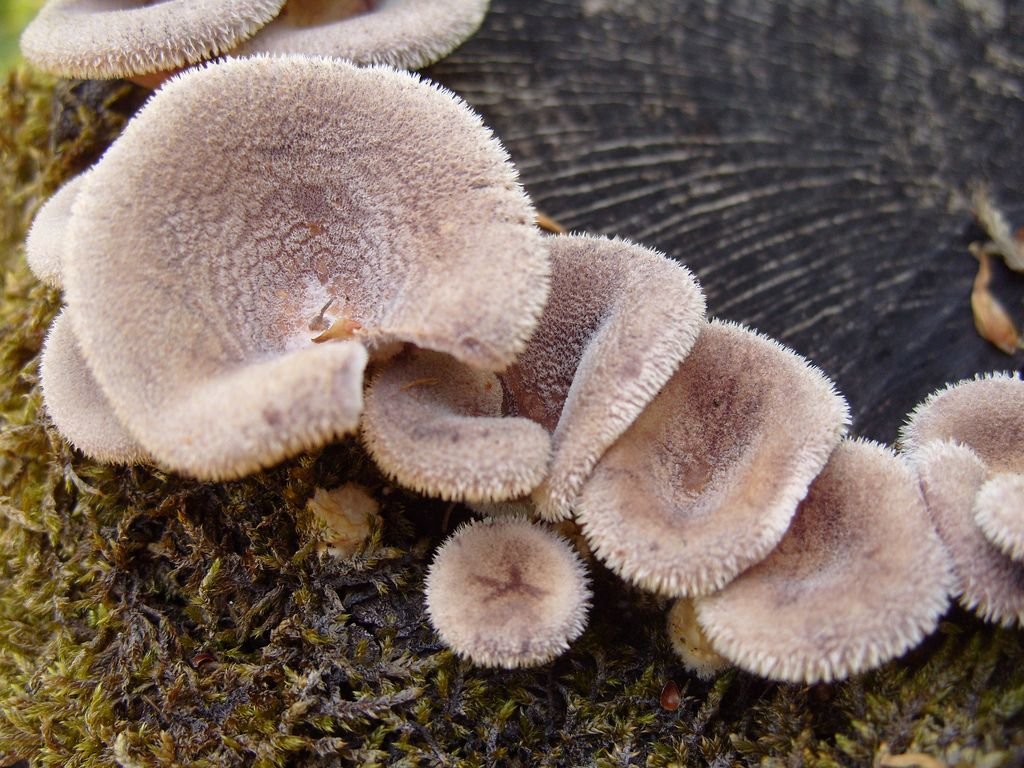
Rough Panus (Panus rudis) is a mushroom from the Polyporov family, actually tinder. Belongs to the genus Panus.
External description
Hat. Rough panus has a side cap of an unusual shape, the diameter of which varies from 2 to 7 cm. The shape of the cap is cup-shaped or funnel-shaped, covered with small hairs, characterized by a light brown or yellow-red color.
Pulp. The mushroom pulp does not have a pronounced aroma and taste. Hymenophore. The hymenophore of the coarse panus is lamellar. The plates are of a descending type, going down the leg.In young mushrooms, they have a pale pink tint, then turn yellowish. Rarely located.
Disputes. Spores are white in color, characterized by a rounded-cylindrical shape.
Leg. The leg of a coarse panus is 2-3 cm in thickness, and 1-2 cm in length. It is characterized by high density, unusual shape and the same color as the cap. Its surface is covered with dense small hairs.
Season and habitat of the mushroom
Rough panus grows on stumps of coniferous and deciduous trees, dead woods, coniferous wood buried in the soil. occurs singly or in small groups. The fruiting period begins in June and lasts until August. On the plains it bears fruit only until the end of June, and in the highlands in July-August. There are known cases of the appearance of coarse panus in the autumn period, from September to October.
Other information about the mushroom
Rough panus is used in Georgia as a substitute for pepsin when cooking cheese.
Mushroom photo Panus rough from questions in recognition:
Types of sawfoot mushroom
Tiger saw-leaf (Lentinus tigrinus)
The hat is 4-8 cm in diameter. Its surface is dry, dense, leathery. The color of the cap is white, whitish, with a yellow, creamy or nutty tint. On top of the cap there are concentric brown, almost black fibrous bristly scales, which are darker and densely located in its center. The shape of the cap in young mushrooms is convex, the edge is tucked down, later it becomes depressed in the center, or acquires a funnel-shaped shape, the edge is thin, uneven, and bursting. The leg is 3-8 cm high, about 1.5 cm wide, central. The structure of the leg is dense, rigid. The shape is cylindrical, narrows towards the base and stretches out in a tapered manner, even or curved. Sometimes a ring-shaped "belt" is located on the leg. At the plates, the leg is white, below the "girdle" it is dark, brownish, brownish. The surface of the peduncle is covered with small concentric, brown, sparse scales. The pulp is tough, thin, dense, leathery. The color of the flesh is white, sometimes it acquires a yellow tint with age. The smell and taste are not pronounced, but may depend on which tree stump the mushroom is growing on. Sometimes there is a "pungent" smell.
The mushroom is found throughout the northern hemisphere, in Europe and Asia, as well as in the Urals and the Far East. Usually inhabits forest belts, parks, along roadsides, as well as in places of mass felling of poplars. Sometimes it grows in cities.
The fruiting season for this species is summer-autumn, the mushroom appears en masse from late July to September. In the southern area, distribution is observed already in April. It grows in large intergrowths and groups on deadwood, stumps and trunks of deciduous trees (oak, poplar, willow, fruit trees).
Scaly saw-leaf (Lentinus lepideus)
Young mushrooms are classified as edible, as long as their pulp remains soft enough, mature mushrooms are not eaten.
The diameter of the mushroom cap is 3-12 cm. In young mushrooms, the cap is convex; as the fungus grows, it flattens and becomes funnel-shaped. The surface is dry, yellow, light brown or grayish white, covered with small brownish or brownish scales. Leg up to 6 cm in height, about 1-2.5 cm in thickness. Central, cylindrical, tapers downward, or becomes tapered elongated. The color of the leg is light, whitish, the surface is covered with scales of a red or reddish-brown color. The pulp is elastic, rigid structure with a pleasant mushroom aroma; in mature mature mushrooms, it is woody.
The fungus grows in the northern hemisphere, on the stumps of conifers, on fallen trees, sometimes it is found on telegraph poles and railway sleepers. Grows both singly and in small groups. The fruiting season lasts from early June to late September. Fruit bodies germinate slowly.
Poisonous and inedible species of sawfoot mushroom
Goblet saw-leaf (Lentinus cyathiformis)
Inedible mushroom due to the very high elasticity of the pulp.
The cap is funnel-shaped, up to 25 cm in diameter, reddish-beige in color, the surface is covered with irregular, weakly expressed concentric zones. In mature mushrooms, the cap fades to whitish, a dark spot remains in the center. The shape of the cap is hemispherical at first, gradually it opens and becomes funnel-shaped, the edge is uneven. The surface is dry, slightly fleecy. The pulp is white, elastic, has a pleasant smell that resembles the smell of fruit. The leg is short and thick, 3-8 cm high, 1-3 cm thick, tapers towards the base, the structure is rigid, the surface of the leg is almost completely covered with plates, blackish at the base.
The goblet saw-leaf grows on decaying deciduous trees (sometimes it also parasitizes living trees, causing white rot). It is a southern mushroom that is rarely found in the northern temperate latitudes. The fruit body grows for a long time.
Poisonous similar species of mushrooms for sawleafs are unknown. Due to their characteristic appearance, these mushrooms are not confused with poisonous species.
How to cook a mushroom properly?
It is suitable for pickling and salting, it is also boiled and dried. Cooking is not difficult, the main thing is to collect only young specimens, and to use exactly the hats for cooking. In older mushrooms, the flesh becomes too tough and inedible.
Primary processing before cooking
Since the mushroom does not grow on the ground, but on wood, its surface is usually clean. The legs should be cut and discarded and washed.
Cooking
The spatula is boiled in salted water for 30 minutes. After such processing, it can be added to stews or other dishes, cook soup with it. Sawwood goes well with meat.
Pickling
A marinade is prepared for boiled mushrooms. For 1 liter of water you will need:
- 1 tbsp. l. salt;
- 1 tbsp. l. Sahara;
- 1 laurel leaf;
- 3 carnation buds;
- 2 tsp vinegar;
- horseradish and currant leaves if desired;
- 3 cloves of garlic, minced.
All this is placed in a saucepan with water and put on the fire, after boiling mushrooms are poured into it, boiled for another 15 minutes. Then the sleepers are laid out on the banks, poured with marinade, closed with lids. Store them in the refrigerator on the bottom shelf.
Salting
Pre-boiled mushrooms are also used for her. After decanting from excess water, the saw-leaves are placed in a prepared container in layers, which are sprinkled with salt and favorite spices. It can be garlic, sweet peas, bay leaves, cloves and others.
Then everything is covered with gauze in several layers and pressed with a load. Mushrooms are salted for 40 days, while it is periodically necessary to rinse the fabric or lay a new one to avoid blooming. A week after the start of the process, the mushrooms should be completely covered with juice, if this has not happened, you need to increase the load or add salt water (1 liter - 2 tablespoons of salt).
At the end, the mushrooms should be laid out in jars, pour the remaining space with brine and put the product in a dark, cool place.
Drying
For her, the mushrooms also need to be boiled first, and then, laid out on a baking sheet, dried in the oven or airfryer. To make the process go faster, the caps should be cut into smaller pieces and periodically turned over. Drying will take at least 5 hours.
The spore mushroom is not common, so it is rarely harvested and eaten, but it is not considered poisonous. And in some countries it even refers to medicinal ones. It has no particular taste value, and is often referred to as the third or fourth group.
Whether or not to collect scaly saw leaves - everyone decides for himself, but if there are mushrooms in the forest that are tastier and healthier, then it is better to pay attention to them
Rough panus (bristly saw-leaf): photo and description
| Name: | Panus rough |
| Latin name: | Panus rudis |
| Type of: | Conditionally edible |
| Synonyms: | Bristly sawfoot, Bristly Lentinus, Agaricus strigosus, Lentinus strigosus, Panus fragilis, Lentinus lecomtei |
| Specifications: |
|
| Systematics: |
|
Rough Panus is a representative of a large group of the Panus clan. These mushrooms are also called saw-leaves. The Latin name for the bristly saw-leaf is Panus rudis. The genus is distinguished by a high concentration of protein. Mature specimens are much tougher than young ones, which is the reason for the name of the species. At the same time, the latter are well absorbed, do not create problems for the work of the digestive tract. Another feature that gave the mushroom its name is the ability to destroy wood on trees and stumps. Even artificial structures on which panus grow do not remain unharmed.

What does Panus look like rough
You need to describe the variety in full. This makes it possible for mushroom pickers to accurately determine the name and belonging of the fruiting body to a well-known family.
Panus consists of a cap and a leg, so the focus is on these parts.
Description of the hat
The cap of the bristly saw-leaf has an unusual shape. Most often it is lateral, funnel-shaped or cupped. The surface is strewn with tiny hairs.
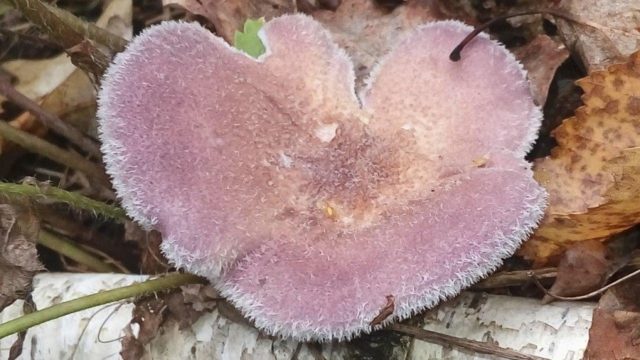
Coloring - yellow-red or light brown, sometimes with pink. The diameter of the cap is from 2 cm to 7 cm. The pulp is without pronounced taste and odor, white spore powder, cylindrical spores.
Leg description
This part of the mushroom is very short, the length of the leg is not more than 2 cm. The thickness is the same, it can be found on some specimens up to 3 cm. Dense, the color is identical to the hat, the leg is covered with hairs.

Where and how it grows
The fungus prefers deciduous or coniferous plantings, highlands. Occurs on deadwood, coniferous wood, especially buried in the ground. Grows singly or in small groups. Fruiting from the end of June, in high-mountain areas a little later - from the end of July or in August. Some lovers of "quiet hunting" celebrate the appearance of the rough panus in the autumn months (September, October). Lives in the Urals, the Caucasus, in the forests of the Far East and Siberia. Occurs in mass felling of trees, dead wood.

It can grow in unusual places, for example, as another representative of sawleafs in the video:
Is the mushroom edible or not
Scientists have classified the species as conditionally edible mushrooms. This suggests that panus can be consumed after preliminary preparation - soaking, boiling (25 minutes). It is recommended to cook dishes from the caps of young specimens of bristly sawfoot. It is better to discard old mushrooms and legs.
Many mushroom pickers believe that the nutritional value of the species is low. They try to use it fresh, without making preparations. The exception is pickling.

Doubles and their differences
In nature, there is a fairly large number of saw-leaves. There are species that an inexperienced mushroom picker can confuse with each other. However, the bristly variety has been poorly studied. Therefore, scientists have not identified at the moment species similar to it. Other panus have too distinctive external parameters (color), which do not allow them to be mistaken for a rough panus.
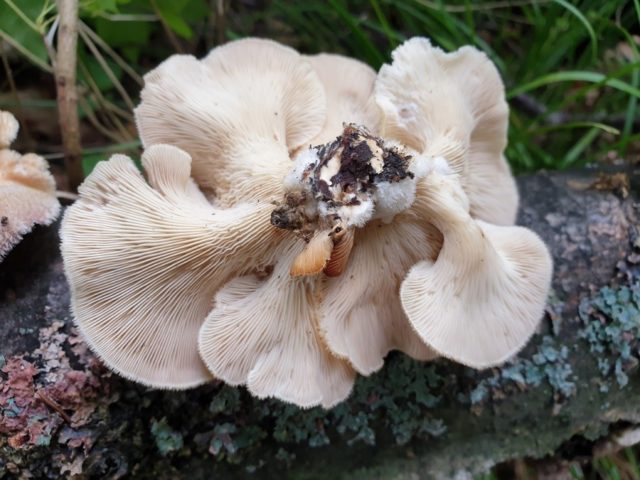
Conclusion
Rough Panus has an unusual appearance, but can significantly diversify the diet. The description and photo will help mushroom pickers easily find fruit bodies in order to move them to their basket.

